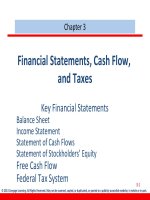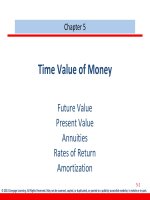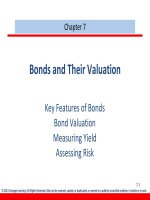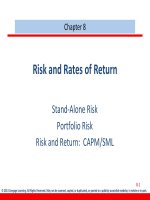Finance management cengage 2013 chapter 05
Bạn đang xem bản rút gọn của tài liệu. Xem và tải ngay bản đầy đủ của tài liệu tại đây (163.8 KB, 44 trang )
Chapter 5
Time Value of Money
Future Value
Present Value
Annuities
Rates of Return
Amortization
5-1
© 2013 Cengage Learning. All Rights Reserved. May not be scanned, copied, or duplicated, or posted to a publicly accessible website, in whole or in part.
Time Lines
0
CF0
•
•
I%
1
2
3
CF1
CF2
CF3
Show the timing of cash flows.
Tick marks occur at the end of periods, so Time 0 is
today; Time 1 is the end of the first period (year,
month, etc.) or the beginning of the second period.
5-2
© 2013 Cengage Learning. All Rights Reserved. May not be scanned, copied, or duplicated, or posted to a publicly accessible website, in whole or in part.
Drawing Time Lines
$100 lump sum due in 2 years
0
I%
1
2
100
3-year $100 ordinary annuity
0
I%
1
2
3
100
100
100
5-3
© 2013 Cengage Learning. All Rights Reserved. May not be scanned, copied, or duplicated, or posted to a publicly accessible website, in whole or in part.
Drawing Time Lines
Uneven cash flow stream
0
-50
I%
1
2
3
100
75
50
5-4
© 2013 Cengage Learning. All Rights Reserved. May not be scanned, copied, or duplicated, or posted to a publicly accessible website, in whole or in part.
What is the future value (FV) of an initial $100
after 3 years, if I/YR = 10%?
•
Finding the FV of a cash flow or series of cash flows
is called compounding.
•
FV can be solved by using the step-by-step,
financial calculator, and spreadsheet methods.
0
100
10%
1
2
3
FV = ?
5-5
© 2013 Cengage Learning. All Rights Reserved. May not be scanned, copied, or duplicated, or posted to a publicly accessible website, in whole or in part.
Solving for FV:
The Step-by-Step and Formula Methods
•
After 1 year:
FV1
= PV(1 + I) = $100(1.10) = $110.00
•
After 2 years:
FV2
= PV(1 + I)2 = $100(1.10)2 = $121.00
•
After 3 years:
FV3
= PV(1 + I)3 = $100(1.10)3 = $133.10
•
After N years (general case):
FVN
= PV(1 + I)N
5-6
© 2013 Cengage Learning. All Rights Reserved. May not be scanned, copied, or duplicated, or posted to a publicly accessible website, in whole or in part.
Solving for FV:
Calculator and Excel Methods
•
•
Solves the general FV equation.
Requires 4 inputs into calculator, and will solve for
the fifth. (Set to P/YR = 1 and END mode.)
INPUTS
OUTPUT
3
10
-100
0
N
I/YR
PV
PMT
FV
133.10
5-7
Excel:
=FV(rate,nper,pmt,pv,type)
© 2013 Cengage Learning. All Rights Reserved. May not be scanned, copied, or duplicated, or posted to a publicly accessible website, in whole or in part.
What is the present value (PV) of $100 due in
3 years, if I/YR = 10%?
•
Finding the PV of a cash flow or series of cash flows
is called discounting (the reverse of compounding).
•
The PV shows the value of cash flows in terms of
today’s purchasing power.
0
1
2
3
10%
PV = ?
100
5-8
© 2013 Cengage Learning. All Rights Reserved. May not be scanned, copied, or duplicated, or posted to a publicly accessible website, in whole or in part.
Solving for PV:
The Formula Method
•
Solve the general FV equation for PV:
PV
= FVN /(1 + I)N
PV
= FV3 /(1 + I)3
= $100/(1.10)3
= $75.13
5-9
© 2013 Cengage Learning. All Rights Reserved. May not be scanned, copied, or duplicated, or posted to a publicly accessible website, in whole or in part.
Solving for PV:
Calculator and Excel Methods
•
•
Solves the general FV equation for PV.
Exactly like solving for FV, except we have different
input information and are solving for a different
variable.
INPUTS
OUTPUT
3
10
N
I/YR
PV
0
100
PMT
FV
-75.13
Excel: =PV(rate,nper,pmt,fv,type)
5-10
© 2013 Cengage Learning. All Rights Reserved. May not be scanned, copied, or duplicated, or posted to a publicly accessible website, in whole or in part.
Solving for I: What annual interest rate would cause
$100 to grow to $125.97 in 3 years?
•
•
Solves the general FV equation for I/YR.
Hard to solve without a financial calculator or
spreadsheet.
INPUTS
3
N
OUTPUT
I/YR
-100
0
125.97
PV
PMT
FV
8
Excel: =RATE(nper,pmt,pv,fv,type,guess)
5-11
© 2013 Cengage Learning. All Rights Reserved. May not be scanned, copied, or duplicated, or posted to a publicly accessible website, in whole or in part.
Solving for N: If sales grow at 20% per year, how
long before sales double?
•
•
Solves the general FV equation for N.
Hard to solve without a financial calculator or
spreadsheet.
INPUTS
N
OUTPUT
20
-1
0
2
I/YR
PV
PMT
FV
3.8
EXCEL: =NPER(rate,pmt,pv,fv,type)
5-12
© 2013 Cengage Learning. All Rights Reserved. May not be scanned, copied, or duplicated, or posted to a publicly accessible website, in whole or in part.
What is the difference between an ordinary
annuity and an annuity due?
Ordinary Annuity
0
I%
1
2
3
PMT
PMT
PMT
1
2
3
PMT
PMT
Annuity Due
0
PMT
I%
5-13
© 2013 Cengage Learning. All Rights Reserved. May not be scanned, copied, or duplicated, or posted to a publicly accessible website, in whole or in part.
Solving for FV:
3-Year Ordinary Annuity of $100 at 10%
•
$100 payments occur at the end of each period, but
there is no PV.
INPUTS
3
10
0
-100
N
I/YR
PV
PMT
OUTPUT
Excel: =FV(rate,nper,pmt,pv,type)
Here type = 0.
FV
331
5-14
© 2013 Cengage Learning. All Rights Reserved. May not be scanned, copied, or duplicated, or posted to a publicly accessible website, in whole or in part.
Solving for PV:
3-year Ordinary Annuity of $100 at 10%
•
$100 payments still occur at the end of each period,
but now there is no FV.
INPUTS
OUTPUT
3
10
N
I/YR
PV
100
0
PMT
FV
-248.69
Excel: =PV(rate,nper,pmt,fv,type)
Here type = 0.
5-15
© 2013 Cengage Learning. All Rights Reserved. May not be scanned, copied, or duplicated, or posted to a publicly accessible website, in whole or in part.
Solving for FV:
3-Year Annuity Due of $100 at 10%
•
•
Now, $100 payments occur at the beginning of each
period.
FVAdue= FVAord(1 + I) = $331(1.10) = $364.10
Alternatively, set calculator to “BEGIN” mode and solve
for the FV of the annuity:
BEGIN
INPUTS
3
10
0
-100
N
I/YR
PV
PMT
OUTPUT
Excel: =FV(rate,nper,pmt,pv,type)
FV
364.10
5-16
© 2013 Cengage Learning. All Rights Reserved. May not be scanned, copied, or duplicated, or posted to a publicly accessible website, in whole or in part.
Solving for PV:
3-Year Annuity Due of $100 at 10%
•
•
Again, $100 payments occur at the beginning of each
period.
PVAdue = PVAord(1 + I) = $248.69(1.10) = $273.55
Alternatively, set calculator to “BEGIN” mode and solve
for the PV of the annuity:
BEGIN
INPUTS
OUTPUT
3
10
N
I/YR
PV
100
0
PMT
FV
-273.55
Excel: =PV(rate,nper,pmt,fv,type)
5-17
© 2013 Cengage Learning. All Rights Reserved. May not be scanned, copied, or duplicated, or posted to a publicly accessible website, in whole or in part.
What is the present value of a 5-year $100
ordinary annuity at 10%?
•
Be sure your financial calculator is set back to END
mode and solve for PV:
– N = 5, I/YR = 10, PMT = -100, FV = 0.
– PV = $379.08.
5-18
© 2013 Cengage Learning. All Rights Reserved. May not be scanned, copied, or duplicated, or posted to a publicly accessible website, in whole or in part.
What if it were a 10-year annuity? A 25-year
annuity? A perpetuity?
•
10-year annuity
– N = 10, I/YR = 10, PMT = -100, FV = 0; solve for PV =
$614.46.
•
25-year annuity
– N = 25, I/YR = 10, PMT = -100, FV = 0; solve for PV =
$907.70.
•
Perpetuity
– PV = PMT/I = $100/0.1 = $1,000.
5-19
© 2013 Cengage Learning. All Rights Reserved. May not be scanned, copied, or duplicated, or posted to a publicly accessible website, in whole or in part.
The Power of Compound Interest
A 20-year-old student wants to save $3 a day for her
retirement. Every day she places $3 in a drawer. At
the end of the year, she invests the accumulated
savings ($1,095) in a brokerage account with an
expected annual return of 12%.
How much money will she have when she is 65 years
old?
5-20
© 2013 Cengage Learning. All Rights Reserved. May not be scanned, copied, or duplicated, or posted to a publicly accessible website, in whole or in part.
Solving for FV: If she begins saving today, how much
will she have when she is 65?
•
If she sticks to her plan, she will have $1,487,261.89
when she is 65.
INPUTS
45
12
0
-1095
N
I/YR
PV
PMT
OUTPUT
FV
1,487,262
Excel: =FV(.12,45,-1095,0,0)
5-21
© 2013 Cengage Learning. All Rights Reserved. May not be scanned, copied, or duplicated, or posted to a publicly accessible website, in whole or in part.
Solving for FV: If you don’t start saving until you are
40 years old, how much will you have at 65?
•
If a 40-year-old investor begins saving today, and
sticks to the plan, he or she will have $146,000.59
at age 65. This is $1.3 million less than if starting at
age 20.
•
Lesson: It pays to start saving early.
INPUTS
25
12
0
-1095
N
I/YR
PV
PMT
OUTPUT
FV
146,001
5-22
© 2013 Cengage Learning. All Rights Reserved. May not be scanned, copied, or duplicated, or posted to a publicly accessible website, in whole or in part.
Excel: =FV(.12,25,-1095,0,0)
Solving for PMT: How much must the 40-year old
deposit annually to catch the 20-year old?
•
To find the required annual contribution, enter the
number of years until retirement and the final goal
of $1,487,261.89, and solve for PMT.
INPUTS
25
12
0
N
I/YR
PV
OUTPUT
1487262
PMT
FV
-11,154.42
Excel: =PMT(rate,nper,pv,fv,type)
5-23
=PMT(.12,25,0,1487262,0)
© 2013 Cengage Learning. All Rights Reserved. May not be scanned, copied, or duplicated, or posted to a publicly accessible website, in whole or in part.
What is the PV of this uneven cash flow stream?
0
10%
1
2
3
4
100
300
300
-50
90.91
247.93
225.39
-34.15
530.08 = PV
5-24
© 2013 Cengage Learning. All Rights Reserved. May not be scanned, copied, or duplicated, or posted to a publicly accessible website, in whole or in part.
Solving for PV:
Uneven Cash Flow Stream
•
Input cash flows in the calculator’s “CFLO” register:
– CF = 0
– CF = 100
– CF = 300
– CF = 300
– CF = -50
0
1
2
3
4
•
Enter I/YR = 10, press NPV button to get NPV =
$530.087. (Here NPV = PV.)
5-25
© 2013 Cengage Learning. All Rights Reserved. May not be scanned, copied, or duplicated, or posted to a publicly accessible website, in whole or in part.









